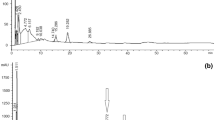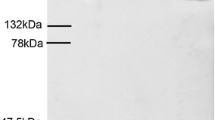Abstract
A quantitative immunological method was developed for measuring serum vitellogenin levels of Reeves' pond turtles (Chinemys reevesii) to investigate the effects of endocrine disruptors on the freshwater ecosystem. Vitellogenin was induced by injecting estradiol-17β into C. reevesii turtles (adult females, juvenile females, and males) and was purified from the turtle serum by EDTA-MgCl2 precipitation followed by gel filtration. Using a polyclonal antibody raised against C. reevesii vitellogenin, an enzyme-linked immunosorbant assay was established. The detectable range, recovery of vitellogenin, and coefficient of variation in this assay were 0.0040–1.0 μg·ml−1, 85.3–109% and 3.4–11.5%, respectively. This assay was also applicable for measurement of the concentrations of vitellogenins from other species, Japanese pond turtles (Mauremys japonica) and red-eared turtles (Trachemys scripta). The serum vitellogenin concentration of 131 C. reevesii turtles captured at a Japanese local river was measured by the assay. In females, vitellogenin ranged from 0.10 μg·ml−1 to 15,000 μg·ml−1 with two peaks, 0.10–1.0 μg·ml−1 (juveniles) and 1,000–10,000 μg·ml−1 (adults). However, in males, it ranged from 0.10 μg·ml−1 to 0.60 μg·ml−1, showing one peak, 0.10–0.20 μg·ml−1. Therefore, if relatively high concentrations of vitellogenin are detected in males or juvenile females, it is suggested that they would have been exposed to xenobiotic estrogens.









Similar content being viewed by others
Abbreviations
- CV :
-
coefficient of variation
- E 2 :
-
estradiol-17β
- EDs :
-
endocrine disruptors
- ELISA :
-
enzyme-linked immunosorbant assay
- NHS-biotin :
-
biotinamidocaproate N-hydroxy succinimide ester
- PBS :
-
phosphate-buffered saline
- SDS-PAGE :
-
sodium dodecylsulfate polyacrylamide gel electrophoresis
- VTG :
-
vitellogenin
References
Bryan GW, Gibbs PE, Burt GR (1988) A comparison of the effectiveness of tri-n-butyltin chloride and five other organotin compounds in promoting the development of imposex in the dog-whelk, Nucella lapillus. J Mar Biol Assoc UK 68:733–744
Colborn T, Saal FS vom, Soto AM (1993) Developmental effects of endocrine-disrupting chemicals in wildlife and humans. Environ Health Perspect 101:378–384
Denslow ND (1999) Vitellogenin as a biomarker of exposure for estrogen or estrogen mimics. Ecotoxicology 8:385–398
Duggan A, Paolucci M, Tercyak A, Gigliotti M, Small D, Callard I (2001) Seasonal variation in plasma lipids, lipoproteins, apolipoprotein A-I and vitellogenin in the freshwater turtle, Chysemys picta. Comp Biochem Physiol A 130:253–269
Facemire CF, Gross TS, Guillette LJ Jr (1995) Reproductive impairment in the Florida panther: nature or nurture? Environ Health Perspect 103:79–86
Fry DM, Toone CK, Speich SM, Peard RJ (1987) Sex ratio skew and breeding patterns of gulls: demographic and toxicological considerations. Stud Avian Biol 10:26–43
Guillette LJ Jr, Gross TS, Masson GR, Matter JM, Percival HF, Woodward AR (1994) Developmental abnormalities of the gonad and abnormal sex hormone concentrations in juvenile alligators from contaminated and control lakes in Florida. Environ Health Perspect 102:680–688
Hara A, Sullivan CV, Dickhoff WW (1993) Isolation and some characterization of vitellogein and its related egg yolk proteins from coho salmon (Oncorhynchus kisutch). Zool Sci 10:245–256
Hashimoto S, Bessho H, Sato K, Hara A, Fujita K (1998) Vitellogenin in wild male flounder, Pleuronectes yokohamae, in Tokyo bay, Japan. Jpn J Environ Toxicol 1:75–85
Heppell SA, Denslow ND, Folmar LC, Sullivan CV (1995) Universal assay of vitellogenin as a biomarker for environmental estrogens. Environ Health Perspect 103:9-15
Ho SM (1987) Endocrinology of vitellogenesis. In: Norris DO, Jones RE (eds) Hormones and reproduction in fishes, amphibians and reptiles. Plenum, New York, pp 145–169
Horiguchi T, Shiraishi H, Shimizu M, Morita M (1994) Imposex and organotin compounds in Thais clavigera and T. bronni in Japan. J Mar Bio Assoc UK 74:651–669
Howell WM, Black DA, Bortone SA (1980) Abnormal expression of secondary sex characteristics in a population of mosquitofish, Gambusia affinis holbrooki: evidence for environmentally-induced masculinization. Copeia 1980:676–681
Jobling S, Sumpter JP (1993) Detergent components in sewage effluent are weakly oestrogenic to fish: an in vitro study using rainbow trout (Oncorhynchus mykiss) hepatocytes. Aquat Toxicol 27:361–372
Kera Y, Kato T, Koshiba K, Yamada R (2000) Koi carp (Cyprinus carpio) vitellogenin: purification, N-terminal and internal amino acid sequences and establishment of an enzyme-linked immunosorbent assay (ELISA). Jpn J Environ Toxicol 3:47–62
Kera Y, Koshiba K, Kato T, Hayakawa S, Takahashi S, Yamada R (2001) Plasma vitellogenin concentration of wild koi carp (Cyprinus carpio) in the Shinamo River and wetland sites in Niigata Prefecture. Jpn J Environ Toxicol 4:35–43
Kubiak TJ, Harris HJ, Smith LM, Schwartz TR, Stalling DL, Trick JA, Sileo L, Docherty DE, Erdman TC (1989) Microcontaminants and reproductive impairment of the Forster's tern on Green Bay, Lake Michigan-1983. Arch Environ Contam Toxicol 18:706–727
Moll EO (1979) Reproductive cycles and adaptations. In: Harless M, Morlock H (eds) Turtles perspectives and research. John Wiley, New York, pp 305–331
Munkittrick KR, Portt CB, Kraak GJ van der, Smith IR, Rokosh DA (1991) Impact of bleached kraft mill effluent on population characteristics, liver MFO activity, and serum steroid levels of a Lake Superior white sucker (Catostomus commersoni) population. Can J Fish Aquat Sci 48:1371–1380
Obst FJ, Richter K, Jacob U (1984) The completely illustrated atlas of reptiles and amphibians for the terrarium. T.F.H., Neptune, N.J.
Palmer BD, Palmer SK (1995) Vitellogenin induction by xenobiotic estrogens in the red-eared turtle and African clawed frog. Environ Health Perspect 103:19–25
Purdom CE, Hardiman PA, Bye VJ, Eno NC, Tyler CR, Sumpter JP (1994) Estrogenic effects of effluents from sewage treatments works. Chem Ecol 8:275–285
Reijnders PJH (1986) Reproductive failure in common seals feeding on fish from polluted coastal waters. Nature 324:456–457
Stephens GA, Creekmore JS (1983) Blood collection by cardiac puncture in conscious turtles. Copeia 1983:522–523
Wallace RA (1985) Vitellogenesis and oocyte growth in nonmammalian vertebrates. In: Browder LW (ed) Developmental biology vol 1. Plenum, New York, pp 127–177
Yasukawa Y (1996) In: Sengoku S, Hikida T, Matsui M, Nakaya K (eds) The encyclopedia of animals in Japan vol 5: amphibians, reptiles, chondrichthyes (in Japanese). Heibonsha, Tokyo, pp 58–63
Yokota H, Morita H, Nakano N, Kang IJ, Tadokoro H, Oshima Y, Honjo T, Kobayashi K (2001) Development of an ELISA for determination of the hepatic vitellogenin in medaka (Oryzias latipes). Jpn J Environ Toxicol 4:87–98
Acknowledgements
We would like to thank Louis J. Guillette Jr. for providing literature on subjects related to this article. We also thank Takashi Yabe, Yuichiro Yasukawa, and Naoki Kamezaki for helpful advice in capturing and handling turtles. The experiments performed comply with the current laws of Japan.
Author information
Authors and Affiliations
Corresponding author
Additional information
Communicated by G. Heldmaier
Rights and permissions
About this article
Cite this article
Tada, N., Saka, M., Ueda, Y. et al. Comparative analyses of serum vitellogenin levels in male and female Reeves' pond turtles (Chinemys reevesii) by an immunological assay. J Comp Physiol B 174, 13–20 (2004). https://doi.org/10.1007/s00360-003-0384-2
Accepted:
Published:
Issue Date:
DOI: https://doi.org/10.1007/s00360-003-0384-2




